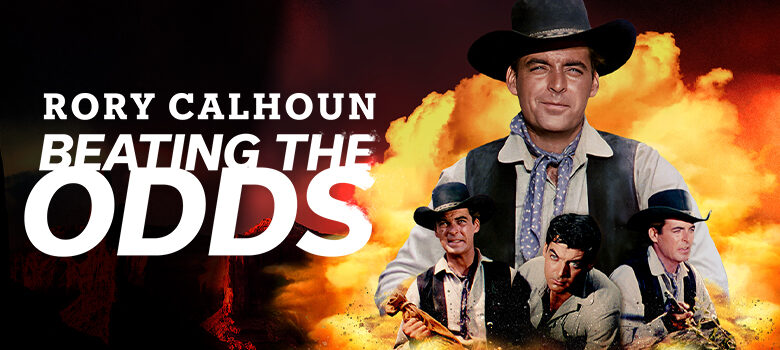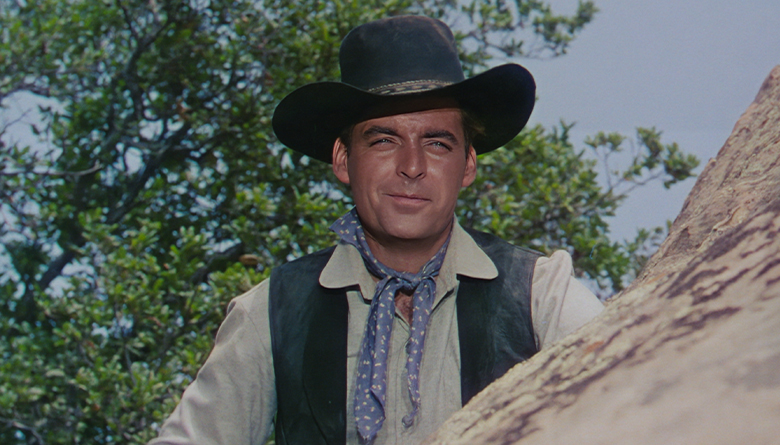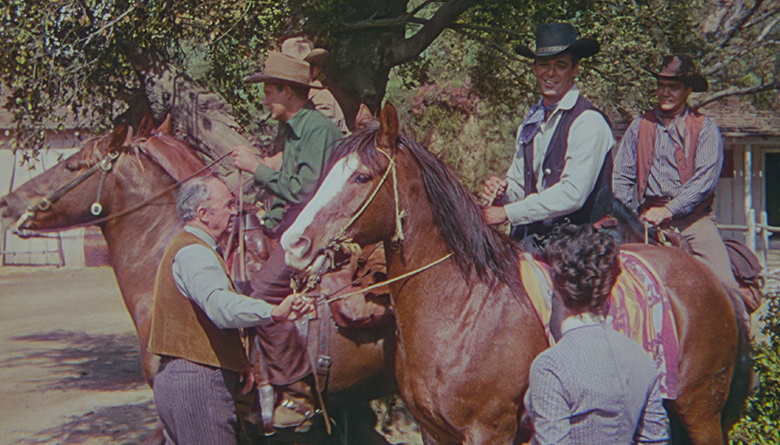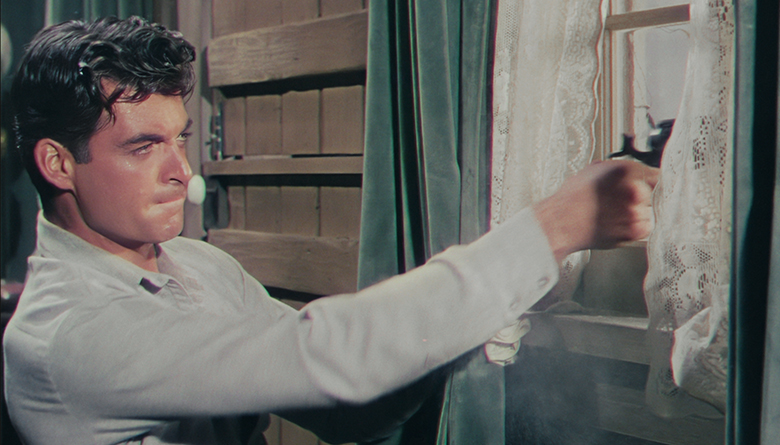Rory Calhoun: His Difficult Past and Rise to Fame

Rory Calhoun—The Man Who Got a Second Chance
by Henry C. Parke
“I mean in all my life I’ve been nothing. I grifted, cheated, tin-horned all my life. I waited for the one big chance a man gets and this is mine. I’m not gonna lose it or risk it or go back to being what I was before.” —Rory Calhoun as Harry in The River of No Return.
Considering Rory Calhoun’s film career—over a hundred dynamic film and TV roles, including 33 Western movies and his series, The Texan—it’s remarkable how little his work is known today. But Rory, who died in 1999, has slipped through the cracks. Like George Montgomery and Guy Madison—incidentally, Rory’s closest friend—his fine work hasn’t yet been rediscovered by new Western fans. That’s because he didn’t work for Ford or Hawks, didn’t co-star with John Wayne or Randolph Scott. And there is no “must-see” movie like Stagecoach on his resumé. Ironically, in his best-known Western, he’s a villain. In The River of No Return, he’s magnetic as Marilyn Monroe’s smiling cobra of a boyfriend, in a life-and-death struggle with Robert Mitchum.
 Rory, “Smoky” to his friends, started life as Francis Timothy McCown. His father, a sailor, was out of his life before Rory was a year old. His mother raised him and, as he said in a 1947 issue of Screenland Magazine, “She let me revel in a regular Tom Sawyer boyhood. I played hooky from school whenever I could, and while I was little enough, I got lickings for it.”
Rory, “Smoky” to his friends, started life as Francis Timothy McCown. His father, a sailor, was out of his life before Rory was a year old. His mother raised him and, as he said in a 1947 issue of Screenland Magazine, “She let me revel in a regular Tom Sawyer boyhood. I played hooky from school whenever I could, and while I was little enough, I got lickings for it.”
Only he played more than hooky and got more than lickings. Starting at age 13, a series of burglaries and car thefts eventually led to a three-year stretch behind bars. Then he took a hot car over state lines and he was facing a possible 20-year sentence. Luckily, he had a champion. Father Daniel Kanaly and Smoky met in prison when the convict had gotten a gun away from a guard and was threatening to use it. Father Kanaly stepped in and offered to box a few rounds with the lad in exchange for the weapon. Smoky agreed, but he never laid a glove on the priest: Smoky didn’t know the priest had boxed in college, and Kanaly would never have guessed the errant youth would make a major career success playing boxer Gentleman Jim Corbett in 1945’s The Great John L. With Father Kanaly in his corner, on August 8, 1943, the day he turned 21, Smoky left Springfield Federal Penitentiary, never to return.
He worked in Oklahoma oil fields and Nevada silver mines before moving to California and becoming a park ranger. “I got four days off each month. I saved up twelve days to travel south and visit my great-grandmother in Culver City. She’s 93 now, and believe me, she’s so sharp!” Being so sharp, great-granny was no doubt aware that M.G.M. was also in Culver City, and 20th Century Fox was right down the road.
The oft-told story is that Smoky went horseback riding and, by chance, met up with movie star Alan Ladd—and the rest is history. While the “cuteness” of that meeting may be an invention, it is true that while trying to get “extra” work at Paramount, Smoky met Mrs. Alma Shedd of the Sue Carol Ladd Agency, who coached him and got him a screen test at Fox, which led to a short-term contract. And at a dinner party at their home, the Ladds introduced Smoky to David O. Selznick’s assistant, Henry Willson. He was helping his boss prepare to film Duel in the Sun, and Willson thought Smoky would be excellent as Gregory Peck’s devil-may-care younger brother. Selznick agreed, put him under contract, and Willson changed Smoky’s name to Rory Calhoun. Ironically, his character was cut out of the Duel in the Sun script, but Selznick started loaning Rory out to other studios, and his career took off. He acted opposite Edward G. Robinson in The Red House, Ronald Reagan in That Hagen Girl, and was soon a bona fide star in The Way of the Gaucho, Four Guns to the Border, How to Marry a Millionaire, and what he considered his best picture, With a Song in My Heart, opposite Susan Hayward. “I learned a lot from that lady…about my trade, about presence in front of the camera, by watching her.”
 Willson left Selznick to start a talent agency, and Rory went with him, moving from star role to star role. Then suddenly, Willson, who had guided his career so successfully, didn’t just throw Rory under a bus, he threw him under a train. Confidential was an infamous scandal sheet and blackmail machine: the editor would bring a not-yet-printed exposé to the subject or their studio and extort money to not print it. Rory learned that Willson had given his entire criminal record to Confidential. Why? Because his most valuable client, Rock Hudson, had a secret that would end his career, and Willson had traded Rory for it.
Willson left Selznick to start a talent agency, and Rory went with him, moving from star role to star role. Then suddenly, Willson, who had guided his career so successfully, didn’t just throw Rory under a bus, he threw him under a train. Confidential was an infamous scandal sheet and blackmail machine: the editor would bring a not-yet-printed exposé to the subject or their studio and extort money to not print it. Rory learned that Willson had given his entire criminal record to Confidential. Why? Because his most valuable client, Rock Hudson, had a secret that would end his career, and Willson had traded Rory for it.
Rory did something no one in his position had ever had the confidence to do before: he beat Confidential to the punch, releasing his criminal record to the press. Incredibly, his career wasn’t damaged. Perhaps if he’d played squeaky-clean characters, it would have been different; but he’d always had a sort of “bad boy” image.
Rory wrote a Western screenplay, Shotgun, to star in, but Allied Artists chose Sterling Hayden instead. Soon after, Rory started his own production company. He co-wrote three films, which were “adult Westerns”, similar in theme to the Randolph Scott/Budd Boetticher and James Stewart/Anthony Mann Westerns. In The Hired Gun, Rory transports escapee Anne Francis to be hanged but grows to suspect her innocence. In Apache Territory, he and a few soldiers and civilians are trapped at a waterhole, under Apache attack. In The Domino Kid, he’s a Reb back from the war, tracking the men who murdered his father and destroyed his farm. Rory rewrote the story in the 1970s as a novel, The Man from Padera.
Few leading men would do a TV series at the time—it was considered career suicide—but Calhoun approached Desi Arnaz, and soon found himself producing, starring, and sometimes writing The Texan, a Western drama that compares well to Gunsmoke and Have Gun – Will Travel. The show was popular, but the pace was grueling—two episodes a week—so after 79 shows in two years, Calhoun turned down a third season.
 While continuing to play in all kinds of stories, he would return to star in Westerns for the rest of his career, guesting on all of the series, starring in the Spaghetti Western Finger on the Trigger, and playing General Meade in the miniseries The Blue and the Gray.
While continuing to play in all kinds of stories, he would return to star in Westerns for the rest of his career, guesting on all of the series, starring in the Spaghetti Western Finger on the Trigger, and playing General Meade in the miniseries The Blue and the Gray.
His final period Western was 1990’s Big Jim, which starred James Brolin and Richard Roundtree and featured Calhoun contemporaries Harry Carey, Jr., and Ty Hardin. His final film, Pure Country, is built around the music of George Strait.
As he told The Los Angeles Times in 1979, “By and large, I suppose my image is Western…You could say there were more B Westerns than A Westerns, but even so, I always enjoyed putting on the hat, strapping on the gun, and feeling like a kid again.”
About Henry C. Parke
Henry’s new book, The Greatest Westerns Ever Made, and the People Who Made Them, published by TwoDot, is now available. The Brooklyn-born, L.A.-based writer has contributed articles to the INSP blog since 2016, been Film Editor for True West since 2015, and has written Henry’s “Western Round-up,” the online report on Western film production, since 2010. His screenwriting credits include Speedtrap (1977) and Double Cross (1994). He’s the first writer welcomed into the Western Writers of America for his work in electronic media. He’s done audio commentary on nearly thirty Spaghetti and domestic Westerns.



